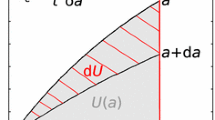Abstract
Rubber to metal bonds are important in a variety of automotive, tire and marine applications. A new technique is discussed for measuring the strain-energy release rates of these adhesively bonded joints in the presence of harsh environments. Guidelines for design and applications are given.
Similar content being viewed by others
References
Stevenson, A., “on the Durability of Rubber/Metal Bonds in Seawater,”Int. J. Adhesion and Adhesives,5 (2),81–91 (April 1985).
Leidheiser, H., Wang, W. andIgetoft, L., “The Mechanism for the Cathodic Delamination of Organic Coatings from a Metal Surface,”Progress in Organic Coatings,11,19–40 (1983).
Wang, W. and Leidheiser, H., “A Model for the Quantitative Interpretation of Cathodic Delamination,” Pourbaix Symp. Volume of the Electrochemical Soc., New Orleans (Oct. 1984).
Koehler, E.L., “The Mechanism of Cathodic Disbondment of Protective Organic Coatings — Aqueous Displacement at Elevated pH,”Corrosion — NACE,40, (1),5–8 (Jan. 1984).
Hammond, J.S., Holubka, J.W. andDickie, R.A., J. Coatings Tech.,51,45 (1979).
Gent, A.N., “Peel Mechanics for an Elastic-Plastic Adherend,”J. Appl. Polymer Sci.,21,2817–2831 (1977).
Ripling, E.J., Mostovoy, S. andPatrick, R.L., Material Res. Stud.,4,129 (1977).
Hetényi, H., “Beam on Elastic Foundation,”Ann Arbor, The University of Michigan Press, 9th printing (1971).
Kanninen, M.E., “An Augmented DCB Model for Studying Crack Propagation and Arrest,”Int. J. Fract.,9 (1), (March 1973).
Gent, A.N. and Meinecke, E.A., “Compression, Bending and Shear of Bonded Rubber Blocks,” Polymer Eng. and Sci.,10 (1), (Jan. 1970).
Gent, A.N., Henry, R.L. and Roxburg, M.L. “Interfacial Stresses for Bonded Rubber Blocks in Compression and Shear,” J. Appl. Mech., 855 (Dec. 1974).
Wang, S.S., Mandel, J.F. and McGarry, F.J., “An Analysis of the Crack Tip Stress Field in DCB Adhesive Fracture Specimens,” Int. J. Fract.,14 (1), (Jan. 1978).
Bascon, W.D. et al., “Effect of Temperature on the Adhesive Fracture Behavior of an Elastomer-Epoxy Resin,”J. Adhesion,7,333 (1976).
Chai, H., “Bond Thickness Effect in Adhesive Joints and its Significance for Mode I Interlaminar Fracture of Composites,” ASTM STP 893, 209 (1986).
Mostovoy, S., Ripling, E.J. andBersh, C.E., “Fracture Toughness of Adhesive Joints”J. Adhesion,3,125 (1971).
Dillard, D.A., Liechti, K., Lefebvre, D.R., Lin, C. and Thornton, J.S., “The Development of Alternate Techniques for Measuring the Fracture Toughness of Rubber to Metal Bonds in Harsh Environments,” ASTM STP 981 (1988).
Author information
Authors and Affiliations
Rights and permissions
About this article
Cite this article
Lefebvre, D.R., Dillard, D.A. & Brinson, H.F. The development of a modified double-cantilever-beam specimen for measuring the fracture energy of rubber to metal bonds. Experimental Mechanics 28, 38–44 (1988). https://doi.org/10.1007/BF02328994
Received:
Accepted:
Issue Date:
DOI: https://doi.org/10.1007/BF02328994




